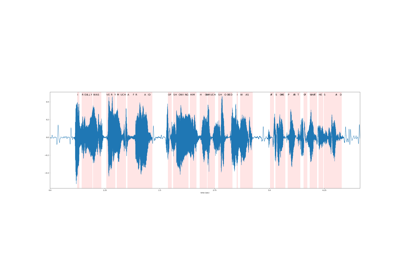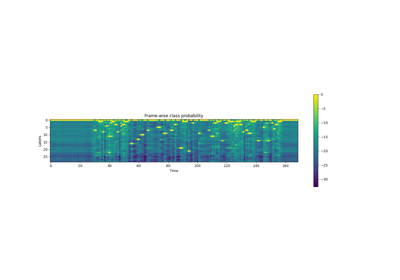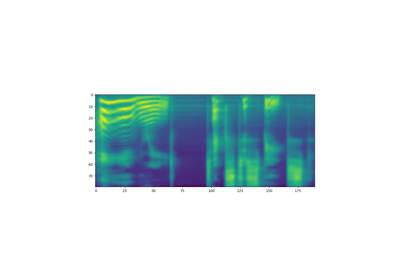torchaudio.pipelines 中¶
pipelines 子包包含用于访问具有预训练权重的模型的 API,以及与预训练权重关联的信息/辅助函数。
RNN-T 流/非流 ASR¶
RNNTBundle¶
-
类 [来源]
torchaudio.pipelines.RNNTBundle¶ 捆绑用于执行自动语音识别(ASR、语音转文本)的组件的数据类 使用 RNN-T 模型进行推理。
更具体地说,该类提供了生成特征化管道 解码器包装指定的 RNN-T 模型,并输出令牌后处理器,它们一起 构成一个完整的端到端 ASR 推理管道,用于生成文本序列 给定一个原始波形。
它可以支持非流式 (完整上下文) 推理以及流式推理。
用户不应直接实例化此类的对象;相反,用户应该使用 模块中存在的实例(表示预先训练的模型), 例如
EMFORMER_RNNT_BASE_LIBRISPEECH.- 例
>>> import torchaudio >>> from torchaudio.pipelines import EMFORMER_RNNT_BASE_LIBRISPEECH >>> import torch >>> >>> # Non-streaming inference. >>> # Build feature extractor, decoder with RNN-T model, and token processor. >>> feature_extractor = EMFORMER_RNNT_BASE_LIBRISPEECH.get_feature_extractor() 100%|███████████████████████████████| 3.81k/3.81k [00:00<00:00, 4.22MB/s] >>> decoder = EMFORMER_RNNT_BASE_LIBRISPEECH.get_decoder() Downloading: "https://download.pytorch.org/torchaudio/models/emformer_rnnt_base_librispeech.pt" 100%|███████████████████████████████| 293M/293M [00:07<00:00, 42.1MB/s] >>> token_processor = EMFORMER_RNNT_BASE_LIBRISPEECH.get_token_processor() 100%|███████████████████████████████| 295k/295k [00:00<00:00, 25.4MB/s] >>> >>> # Instantiate LibriSpeech dataset; retrieve waveform for first sample. >>> dataset = torchaudio.datasets.LIBRISPEECH("/home/librispeech", url="test-clean") >>> waveform = next(iter(dataset))[0].squeeze() >>> >>> with torch.no_grad(): >>> # Produce mel-scale spectrogram features. >>> features, length = feature_extractor(waveform) >>> >>> # Generate top-10 hypotheses. >>> hypotheses = decoder(features, length, 10) >>> >>> # For top hypothesis, convert predicted tokens to text. >>> text = token_processor(hypotheses[0][0]) >>> print(text) he hoped there would be stew for dinner turnips and carrots and bruised potatoes and fat mutton pieces to [...] >>> >>> >>> # Streaming inference. >>> hop_length = EMFORMER_RNNT_BASE_LIBRISPEECH.hop_length >>> num_samples_segment = EMFORMER_RNNT_BASE_LIBRISPEECH.segment_length * hop_length >>> num_samples_segment_right_context = ( >>> num_samples_segment + EMFORMER_RNNT_BASE_LIBRISPEECH.right_context_length * hop_length >>> ) >>> >>> # Build streaming inference feature extractor. >>> streaming_feature_extractor = EMFORMER_RNNT_BASE_LIBRISPEECH.get_streaming_feature_extractor() >>> >>> # Process same waveform as before, this time sequentially across overlapping segments >>> # to simulate streaming inference. Note the usage of ``streaming_feature_extractor`` and ``decoder.infer``. >>> state, hypothesis = None, None >>> for idx in range(0, len(waveform), num_samples_segment): >>> segment = waveform[idx: idx + num_samples_segment_right_context] >>> segment = torch.nn.functional.pad(segment, (0, num_samples_segment_right_context - len(segment))) >>> with torch.no_grad(): >>> features, length = streaming_feature_extractor(segment) >>> hypotheses, state = decoder.infer(features, length, 10, state=state, hypothesis=hypothesis) >>> hypothesis = hypotheses[0] >>> transcript = token_processor(hypothesis[0]) >>> if transcript: >>> print(transcript, end=" ", flush=True) he hoped there would be stew for dinner turn ips and car rots and bru 'd oes and fat mut ton pieces to [...]
- 教程使用:
RNNTBundle
-
get_decoder()→ torchaudio.models.RNNTBeamSearch[来源]¶ 构建 RNN-T 解码器。
- 返回
RNNTBeam搜索
-
get_feature_extractor()→ RNNTBundle.FeatureExtractor[来源]¶ 为非流式处理 (完整上下文) ASR 构造特征提取器。
- 返回
特征提取器
-
get_streaming_feature_extractor()→ RNNTBundle.FeatureExtractor[来源]¶ 为流式处理 (同时) ASR 构造特征提取器。
- 返回
特征提取器
-
get_token_processor()→ RNNTBundle.TokenProcessor[来源]¶ 构造令牌处理器。
- 返回
TokenProcessor 的
RNNTBundle - 特征提取器¶
-
类 [来源]
RNNTBundle.FeatureExtractor¶ -
abstract (输入: torch.Tensor) → Tuple[torch.Tensor、torch 的 Tensor 和 Torch 的 T张肌
__call__]¶ 从给定的输入张量生成特征和长度输出。
- 参数
input (Torch.Tensor) – 输入张量。
- 返回
- torch.Tensor:
特征,形状为 (length, *)。
- torch.Tensor:
长度,形状为 (1,)。
- 返回类型
-
abstract (输入: torch.Tensor) → Tuple[torch.Tensor、torch 的 Tensor 和 Torch 的 T张肌
RNNTBundle - TokenProcessor¶
EMFORMER_RNNT_BASE_LIBRISPEECH¶
-
torchaudio.pipelines.EMFORMER_RNNT_BASE_LIBRISPEECH¶ 预先训练的基于 Emformer-RNNT 的 ASR 管道,能够执行流式和非流式推理。
底层模型由
torchaudio.models.emformer_rnnt_base()并利用在 LibriSpeech 上使用训练脚本训练的权重,此处使用带有默认参数。train.py请参考
RNNTBundle了解使用说明。
wav2vec 2.0 / HuBERT - 表示学习¶
-
类 [来源]
torchaudio.pipelines.Wav2Vec2Bundle¶ Data 类,该类捆绑了相关信息以使用预训练的 Wav2Vec2Model。
此类提供了用于实例化预训练模型的接口,以及 检索预训练权重和其他数据所需的信息 以与模型一起使用。
Torchaudio 库实例化此类的对象,每个对象都表示 不同的预训练模型。客户端代码应通过这些 实例。
有关用法和可用值,请参阅下文。
- 示例 - 特征提取
>>> import torchaudio >>> >>> bundle = torchaudio.pipelines.HUBERT_BASE >>> >>> # Build the model and load pretrained weight. >>> model = bundle.get_model() Downloading: 100%|███████████████████████████████| 360M/360M [00:06<00:00, 60.6MB/s] >>> >>> # Resample audio to the expected sampling rate >>> waveform = torchaudio.functional.resample(waveform, sample_rate, bundle.sample_rate) >>> >>> # Extract acoustic features >>> features, _ = model.extract_features(waveform)
-
get_model(self, *, dl_kwargs=None) → torchaudio.models.Wav2Vec2Model [来源]¶ 构建模型并加载预训练的权重。
权重文件从 Internet 下载,并使用
torch.hub.load_state_dict_from_url()- 参数
dl_kwargs (关键字参数字典) – 传递给
torch.hub.load_state_dict_from_url().
WAV2VEC2_BASE¶
WAV2VEC2_LARGE¶
WAV2VEC2_LARGE_LV60K¶
WAV2VEC2_XLSR53¶
HUBERT_BASE¶
HUBERT_LARGE¶
wav2vec 2.0 / HuBERT - 微调的 ASR¶
Wav2Vec2ASRBundle¶
-
类 [来源]
torchaudio.pipelines.Wav2Vec2ASRBundle¶ Data 类,该类捆绑了相关信息以使用预训练的 Wav2Vec2Model。
此类提供了用于实例化预训练模型的接口,以及 检索预训练权重和其他数据所需的信息 以与模型一起使用。
Torchaudio 库实例化此类的对象,每个对象都表示 不同的预训练模型。客户端代码应通过这些 实例。
有关用法和可用值,请参阅下文。
- 示例 — ASR
>>> import torchaudio >>> >>> bundle = torchaudio.pipelines.HUBERT_ASR_LARGE >>> >>> # Build the model and load pretrained weight. >>> model = bundle.get_model() Downloading: 100%|███████████████████████████████| 1.18G/1.18G [00:17<00:00, 73.8MB/s] >>> >>> # Check the corresponding labels of the output. >>> labels = bundle.get_labels() >>> print(labels) ('-', '|', 'E', 'T', 'A', 'O', 'N', 'I', 'H', 'S', 'R', 'D', 'L', 'U', 'M', 'W', 'C', 'F', 'G', 'Y', 'P', 'B', 'V', 'K', "'", 'X', 'J', 'Q', 'Z') >>> >>> # Resample audio to the expected sampling rate >>> waveform = torchaudio.functional.resample(waveform, sample_rate, bundle.sample_rate) >>> >>> # Infer the label probability distribution >>> emissions, _ = model(waveform) >>> >>> # Pass emission to decoder >>> # `ctc_decode` is for illustration purpose only >>> transcripts = ctc_decode(emissions, labels)
- 教程使用:
Wav2Vec2ASRBundle
-
get_model(self, *, dl_kwargs=None) → torchaudio.models.Wav2Vec2Model¶ 构建模型并加载预训练的权重。
权重文件从 Internet 下载,并使用
torch.hub.load_state_dict_from_url()- 参数
dl_kwargs (关键字参数字典) – 传递给
torch.hub.load_state_dict_from_url().
-
get_labels(*,空白:str = '-') → Tuple[str][来源]¶ 输出类标签(仅适用于经过微调的捆绑商品)
第一个是空白令牌,它是可自定义的。
- 例
>>> import torchaudio >>> torchaudio.models.HUBERT_ASR_LARGE.get_labels() ('-', '|', 'E', 'T', 'A', 'O', 'N', 'I', 'H', 'S', 'R', 'D', 'L', 'U', 'M', 'W', 'C', 'F', 'G', 'Y', 'P', 'B', 'V', 'K', "'", 'X', 'J', 'Q', 'Z')
WAV2VEC2_ASR_BASE_10M¶
-
torchaudio.pipelines.WAV2VEC2_ASR_BASE_10M¶ 使用额外的线性模块构建 “base” wav2vec2 模型
对 LibriSpeech 数据集中 960 小时的未标记音频进行了预训练 [1] (“train-clean-100”、“train-clean-360”和“train-other-500”的组合),以及 对 Libri-Light 数据集中 10 分钟转录音频的 ASR 进行微调 [3](“train-10min”子集)。
最初由 wav2vec 2.0 的作者发布 [2] 在 MIT 许可证下,并且 使用相同的许可证重新分发。 [许可证、来源]
WAV2VEC2_ASR_BASE_100H¶
WAV2VEC2_ASR_BASE_960H¶
WAV2VEC2_ASR_LARGE_10M¶
-
torchaudio.pipelines.WAV2VEC2_ASR_LARGE_10M¶ 使用额外的线性模块构建“大型” wav2vec2 模型
对 LibriSpeech 数据集中 960 小时的未标记音频进行了预训练 [1] (“train-clean-100”、“train-clean-360”和“train-other-500”的组合),以及 对 Libri-Light 数据集中 10 分钟转录音频的 ASR 进行微调 [3](“train-10min”子集)。
最初由 wav2vec 2.0 的作者发布 [2] 在 MIT 许可证下,并且 使用相同的许可证重新分发。 [许可证、来源]
WAV2VEC2_ASR_LARGE_100H¶
WAV2VEC2_ASR_LARGE_960H¶
WAV2VEC2_ASR_LARGE_LV60K_10M¶
WAV2VEC2_ASR_LARGE_LV60K_100H¶
WAV2VEC2_ASR_LARGE_LV60K_960H¶
-
torchaudio.pipelines.WAV2VEC2_ASR_LARGE_LV60K_960H¶ 使用额外的线性模块构建 “large-lv60k” wav2vec2 模型
对来自 Libri-Light [3] 数据集的 60,000 小时未标记音频进行预训练,以及 对 LibriSpeech 数据集中 960 小时转录音频的 ASR 进行了微调 [1] (“train-clean-100”、“train-clean-360”和“train-other-500”的组合)。
最初由 wav2vec 2.0 的作者发布 [2] 在 MIT 许可证下,并且 使用相同的许可证重新分发。 [许可证、来源]
VOXPOPULI_ASR_BASE_10K_DE¶
VOXPOPULI_ASR_BASE_10K_EN¶
VOXPOPULI_ASR_BASE_10K_ES¶
VOXPOPULI_ASR_BASE_10K_FR¶
VOXPOPULI_ASR_BASE_10K_IT¶
HUBERT_ASR_LARGE¶
Tacotron2 文本转语音¶
Tacotron2TTSBundle¶
-
类 [来源]
torchaudio.pipelines.Tacotron2TTSBundle¶ 捆绑相关信息以使用预训练的 Tacotron2 和声码器的数据类。
此类提供了用于实例化预训练模型的接口,以及 检索预训练权重和其他数据所需的信息 以与模型一起使用。
Torchaudio 库实例化此类的对象,每个对象都表示 不同的预训练模型。客户端代码应通过这些 实例。
有关用法和可用值,请参阅下文。
- 示例 - 使用 Tacotron2 和 WaveRNN 的基于字符的 TTS 管道
>>> import torchaudio >>> >>> text = "Hello, T T S !" >>> bundle = torchaudio.pipelines.TACOTRON2_WAVERNN_CHAR_LJSPEECH >>> >>> # Build processor, Tacotron2 and WaveRNN model >>> processor = bundle.get_text_processor() >>> tacotron2 = bundle.get_tacotron2() Downloading: 100%|███████████████████████████████| 107M/107M [00:01<00:00, 87.9MB/s] >>> vocoder = bundle.get_vocoder() Downloading: 100%|███████████████████████████████| 16.7M/16.7M [00:00<00:00, 78.1MB/s] >>> >>> # Encode text >>> input, lengths = processor(text) >>> >>> # Generate (mel-scale) spectrogram >>> specgram, lengths, _ = tacotron2.infer(input, lengths) >>> >>> # Convert spectrogram to waveform >>> waveforms, lengths = vocoder(specgram, lengths) >>> >>> torchaudio.save('hello-tts.wav', waveforms, vocoder.sample_rate)
- 示例 - 使用 Tacotron2 和 WaveRNN 的基于音素的 TTS 管道
>>> >>> # Note: >>> # This bundle uses pre-trained DeepPhonemizer as >>> # the text pre-processor. >>> # Please install deep-phonemizer. >>> # See https://github.com/as-ideas/DeepPhonemizer >>> # The pretrained weight is automatically downloaded. >>> >>> import torchaudio >>> >>> text = "Hello, TTS!" >>> bundle = torchaudio.pipelines.TACOTRON2_WAVERNN_PHONE_LJSPEECH >>> >>> # Build processor, Tacotron2 and WaveRNN model >>> processor = bundle.get_text_processor() Downloading: 100%|███████████████████████████████| 63.6M/63.6M [00:04<00:00, 15.3MB/s] >>> tacotron2 = bundle.get_tacotron2() Downloading: 100%|███████████████████████████████| 107M/107M [00:01<00:00, 87.9MB/s] >>> vocoder = bundle.get_vocoder() Downloading: 100%|███████████████████████████████| 16.7M/16.7M [00:00<00:00, 78.1MB/s] >>> >>> # Encode text >>> input, lengths = processor(text) >>> >>> # Generate (mel-scale) spectrogram >>> specgram, lengths, _ = tacotron2.infer(input, lengths) >>> >>> # Convert spectrogram to waveform >>> waveforms, lengths = vocoder(specgram, lengths) >>> >>> torchaudio.save('hello-tts.wav', waveforms, vocoder.sample_rate)
- 教程使用:
Tacotron2TTSBundle
-
摘要 (self, *, dl_kwargs=None) → torchaudio.pipelines.Tacotron2TTSBundle.TextProcessor[来源]
get_text_processor¶ 创建文本处理器
对于基于字符的管道,此处理器按字符拆分输入文本。 对于基于音素的管道,此处理器将输入文本(字素)转换为 音素。
如果需要预训练的权重文件,
torch.hub.download_url_to_file()用于下载它。- 参数
dl_kwargs (keyword arguments,) – 传递给
torch.hub.download_url_to_file().- 返回
一个可调用对象,它以字符串或字符串列表作为输入,并且 返回编码文本的 Tensor 和有效长度的 Tensor。 该对象还具有属性,该属性允许恢复 标记化表单。
tokens- 返回类型
TTSTextProcessor
- 示例 - 基于字符
>>> text = [ >>> "Hello World!", >>> "Text-to-speech!", >>> ] >>> bundle = torchaudio.pipelines.TACOTRON2_WAVERNN_CHAR_LJSPEECH >>> processor = bundle.get_text_processor() >>> input, lengths = processor(text) >>> >>> print(input) tensor([[19, 16, 23, 23, 26, 11, 34, 26, 29, 23, 15, 2, 0, 0, 0], [31, 16, 35, 31, 1, 31, 26, 1, 30, 27, 16, 16, 14, 19, 2]], dtype=torch.int32) >>> >>> print(lengths) tensor([12, 15], dtype=torch.int32) >>> >>> print([processor.tokens[i] for i in input[0, :lengths[0]]]) ['h', 'e', 'l', 'l', 'o', ' ', 'w', 'o', 'r', 'l', 'd', '!'] >>> print([processor.tokens[i] for i in input[1, :lengths[1]]]) ['t', 'e', 'x', 't', '-', 't', 'o', '-', 's', 'p', 'e', 'e', 'c', 'h', '!']
- 示例 - 基于音素
>>> text = [ >>> "Hello, T T S !", >>> "Text-to-speech!", >>> ] >>> bundle = torchaudio.pipelines.TACOTRON2_WAVERNN_PHONE_LJSPEECH >>> processor = bundle.get_text_processor() Downloading: 100%|███████████████████████████████| 63.6M/63.6M [00:04<00:00, 15.3MB/s] >>> input, lengths = processor(text) >>> >>> print(input) tensor([[54, 20, 65, 69, 11, 92, 44, 65, 38, 2, 0, 0, 0, 0], [81, 40, 64, 79, 81, 1, 81, 20, 1, 79, 77, 59, 37, 2]], dtype=torch.int32) >>> >>> print(lengths) tensor([10, 14], dtype=torch.int32) >>> >>> print([processor.tokens[i] for i in input[0]]) ['HH', 'AH', 'L', 'OW', ' ', 'W', 'ER', 'L', 'D', '!', '_', '_', '_', '_'] >>> print([processor.tokens[i] for i in input[1]]) ['T', 'EH', 'K', 'S', 'T', '-', 'T', 'AH', '-', 'S', 'P', 'IY', 'CH', '!']
-
abstract (self, *, dl_kwargs=None) → torchaudio.models.Tacotron2[来源]
get_tacotron2¶ 创建具有预训练权重的 Tacotron2 模型。
- 参数
dl_kwargs (关键字参数字典) – 传递给
torch.hub.load_state_dict_from_url().- 返回
生成的模型。
- 返回类型
-
摘要 (self, *, dl_kwargs=None) → torchaudio.pipelines.Tacotron2TTSBundle.Vocoder[来源]
get_vocoder¶ 基于 WaveRNN 或 GriffinLim 创建声码器模块。
如果需要预训练的权重文件,
torch.hub.load_state_dict_from_url()用于下载它。- 参数
dl_kwargs (关键字参数字典) – 传递给
torch.hub.load_state_dict_from_url().- 返回
一个声码器模块,它接受 spectrogram Tensor 和一个可选的 length Tensor 的 Tensor 中,然后返回生成的波形 Tensor 和可选的 length Tensor 的 Tensor 中。
- 返回类型
Callable[[Tensor, Optional[Tensor]], Tuple[Tensor, Optional[Tensor]]]
Tacotron2TTSBundle - 文本处理器¶
-
类 [来源]
Tacotron2TTSBundle.TextProcessor¶ Tacotron2TTS 流水线的文本处理部分的接口
看
torchaudio.pipelines.Tacotron2TTSBundle.get_text_processor()对于用途。-
abstract 属性
tokens¶ 已处理张量中每个值表示的标记。
看
torchaudio.pipelines.Tacotron2TTSBundle.get_text_processor()对于用途。- 类型
列表[str]
-
摘要 (文本: Union[str, List[str]]) → 元组[torch.Tensor、torch 的 Tensor 和 Torch 的 T张肌
__call__]¶ 将给定的(批次)文本编码为数字张量
看
torchaudio.pipelines.Tacotron2TTSBundle.get_text_processor()对于用途。- 参数
text (str or list of str) – 输入文本。
- 返回
- 张肌:
编码的文本。形状:(批次,最大长度)
- 张肌:
批次中每个样本的有效长度。形状:(batch, )。
- 返回类型
(张量、张量)
-
abstract 属性
Tacotron2TTSBundle - 声码器¶
-
类 [来源]
Tacotron2TTSBundle.Vocoder¶ Tacotron2TTS 管道的声码器部分的接口
看
torchaudio.pipelines.Tacotron2TTSBundle.get_vocoder()对于用途。-
abstract 属性
sample_rate¶ 结果波形的采样率
看
torchaudio.pipelines.Tacotron2TTSBundle.get_vocoder()对于用途。- 类型
-
abstract (specgrams: torch.Tensor, lengths: 可选[torch.Tensor] = None) → Tuple[torch.Tensor,可选[torch.张肌
__call__]]¶ 从给定的输入生成波形,例如频谱图
看
torchaudio.pipelines.Tacotron2TTSBundle.get_vocoder()对于用途。- 参数
specgrams (Tensor) – 输入频谱图。形状:(批次、频率区间、时间)。 预期的形状取决于实现。
lengths (Tensor 或 None,可选) – 批处理中每个样本的有效长度。形状:(batch, )。 (默认值:无)
- 返回
- 张肌:
生成的波形。形状:(批次,最大长度)
- Tensor 或 None:
批次中每个样本的有效长度。形状:(batch, )。
- 返回类型
(Tensor, 可选[Tensor])
-
abstract 属性
TACOTRON2_WAVERNN_PHONE_LJSPEECH¶
-
torchaudio.pipelines.TACOTRON2_WAVERNN_PHONE_LJSPEECH¶ 基于音素的 TTS 管道,其中
torchaudio.models.Tacotron2和torchaudio.models.WaveRNN.文本处理器根据 phoneme 对输入文本进行编码。 它使用 DeepPhonemizer 进行转换 字素转换为音素。 模型 (en_us_cmudict_forward) 在 CMUDict 上进行了训练。
Tacotron2 在 LJSpeech [10] 上训练了 1,500 个 epoch。 您可以在此处找到训练脚本。 使用了以下参数;和。
win_length=1100hop_length=275n_fft=2048mel_fmin=40mel_fmax=11025vocder 基于
torchaudio.models.WaveRNN. 它在 LJSpeech [10] 的 8 位深度波形上进行了 10,000 个 epoch 的训练。 您可以在此处找到训练脚本。请参考
torchaudio.pipelines.Tacotron2TTSBundle()对于用途。示例 — “Hello world!T T S 代表文本到语音!

示例 - “专家的审查和证词使委员会得出结论,可能已经开了五枪,”

TACOTRON2_WAVERNN_CHAR_LJSPEECH¶
-
torchaudio.pipelines.TACOTRON2_WAVERNN_CHAR_LJSPEECH¶ 基于字符的 TTS 管道,具有
torchaudio.models.Tacotron2和torchaudio.models.WaveRNN.文本处理器对输入文本逐个字符进行编码。
Tacotron2 在 LJSpeech [10] 上训练了 1,500 个 epoch。 您可以在此处找到训练脚本。 使用了以下参数;和。
win_length=1100hop_length=275n_fft=2048mel_fmin=40mel_fmax=11025vocder 基于
torchaudio.models.WaveRNN. 它在 LJSpeech [10] 的 8 位深度波形上进行了 10,000 个 epoch 的训练。 您可以在此处找到训练脚本。请参考
torchaudio.pipelines.Tacotron2TTSBundle()对于用途。示例 — “Hello world!T T S 代表文本到语音!

示例 - “专家的审查和证词使委员会得出结论,可能已经开了五枪,”

TACOTRON2_GRIFFINLIM_PHONE_LJSPEECH¶
-
torchaudio.pipelines.TACOTRON2_GRIFFINLIM_PHONE_LJSPEECH¶ 基于音素的 TTS 管道,其中
torchaudio.models.Tacotron2和torchaudio.transforms.GriffinLim.文本处理器根据 phoneme 对输入文本进行编码。 它使用 DeepPhonemizer 进行转换 字素转换为音素。 模型 (en_us_cmudict_forward) 在 CMUDict 上进行了训练。
Tacotron2 在 LJSpeech [10] 上训练了 1,500 个 epoch。 您可以在此处找到训练脚本。 文本处理器设置为 “english_phonemes”。
声码器基于
torchaudio.transforms.GriffinLim.请参考
torchaudio.pipelines.Tacotron2TTSBundle()对于用途。示例 — “Hello world!T T S 代表文本到语音!

示例 - “专家的审查和证词使委员会得出结论,可能已经开了五枪,”

TACOTRON2_GRIFFINLIM_CHAR_LJSPEECH¶
-
torchaudio.pipelines.TACOTRON2_GRIFFINLIM_CHAR_LJSPEECH¶ 基于字符的 TTS 管道,具有
torchaudio.models.Tacotron2和torchaudio.transforms.GriffinLim.文本处理器对输入文本逐个字符进行编码。
Tacotron2 在 LJSpeech [10] 上训练了 1,500 个 epoch。 您可以在此处找到训练脚本。 使用了默认参数。
声码器基于
torchaudio.transforms.GriffinLim.请参考
torchaudio.pipelines.Tacotron2TTSBundle()对于用途。示例 — “Hello world!T T S 代表文本到语音!

示例 - “专家的审查和证词使委员会得出结论,可能已经开了五枪,”

引用¶
- 1(1,2,3,4,5,6,7,8,9,10,11,12,13)
Vassil Panayotov、Guoguo Chen、Daniel Povey 和 Sanjeev Khudanpur。Librispeech:基于公共领域有声读物的 asr 语料库。2015 年 IEEE 声学、语音和信号处理国际会议 (ICASSP),卷,5206–5210。2015. doi:10.1109/ICASSP.2015.7178964.
- 2(1,2,3,4,5,6,7,8,9,10,11,12)
阿列克谢·巴耶夫斯基、亨利·周、阿卜杜勒拉赫曼·穆罕默德和迈克尔·奥利。Wav2vec 2.0:语音表示的自监督学习框架。2020. arXiv:2006.11477.
- 3(1,2,3,4,5,6,7,8,9,10)
J. Kahn, M. Rivière, W. Zheng, E. Kharitonov, Q. Xu, PE Mazaré, J. Karadayi, V. Liptchinsky, R. Collobert, C. Fuegen, T. Likhomanenko, G. Synnaeve, A. Joulin, A. Mohamed, 和 E. Dupoux.Libri-light:有限或无监督的 asr 基准。在 ICASSP 2020 - 2020 IEEE 声学、语音和信号处理国际会议 (ICASSP) 中,7669–7673。2020. https://github.com/facebookresearch/libri-light。
- 4
Vineel Pratap、Qiantong Xu、Anuroop Sriram、Gabriel Synnaeve 和 Ronan Collobert。Mls:用于语音研究的大规模多语言数据集。Interspeech 2020,2020 年 10 月。网址:http://dx.doi.org/10.21437/Interspeech.2020-2826,doi:10.21437/interspeech.2020-2826。
- 5
罗珊娜·阿迪拉、梅根·布兰森、凯利·戴维斯、迈克尔·亨雷蒂、迈克尔·科勒、乔什·迈耶、鲁本·莫莱斯、林赛·桑德斯、弗朗西斯·泰尔斯和格雷戈尔·韦伯。Common voice:一个包含大量多语言的语音语料库。2020. arXiv:1912.06670.
- 6
马克·约翰·弗朗西斯·盖尔斯、凯特·克尼尔、安东·拉格尼和沙克蒂·普拉萨德·拉斯。低资源语言的语音识别和关键字识别:cueed 的 babel 项目研究。在 SLTU.2014.
- 7
亚历克西斯·康诺、阿列克谢·巴耶夫斯基、罗南·科洛伯特、阿卜杜勒拉赫曼·穆罕默德和迈克尔·奥利。用于语音识别的无监督跨语言表示学习。2020. arXiv:2006.13979.
- 8(1,2,3,4,5)
Wei-Ning Hsu、Benjamin Bolte、Yao-Hung Hubert Tsai、Kushal Lakhotia、Ruslan Salakhutdinov 和 Abdelrahman Mohamed。Hubert:通过隐藏单元的掩蔽预测进行自我监督的语音表示学习。2021. arXiv:2106.07447.
- 9(1,2,3,4,5,6,7,8,9,10)
Changhan Wang、Morgane Rivière、Ann Lee、Anne Wu、Chaitanya Talnikar、Daniel Haziza、Mary Williamson、Juan Miguel Pino 和 Emmanuel Dupoux。Voxpopuli:用于表示学习、半监督学习和解释的大规模多语言语音语料库。CoRR,2021 年。网址:https://arxiv.org/abs/2101.00390,arXiv:2101.00390。
- 10(1,2,3,4,5,6)
Keith Ito 和 Linda Johnson。lj 语音数据集。https://keithito.com/LJ-Speech-Dataset/,2017 年。





